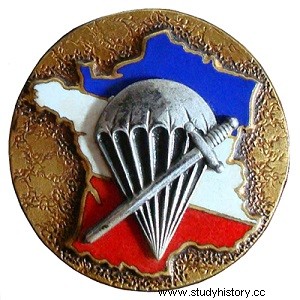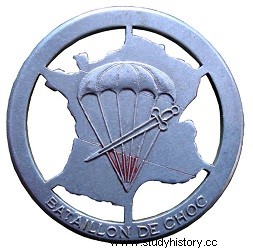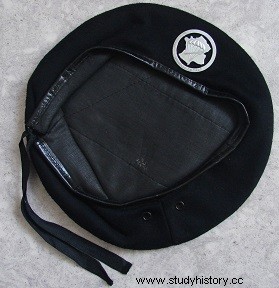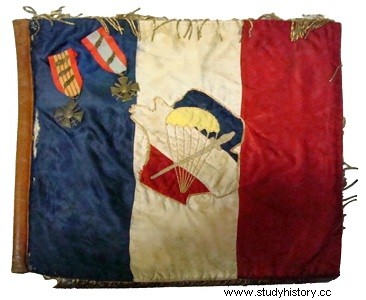
The Shock Battalion is an elite unit of the French Army formed in May 1943 in Staoueli, Algeria. Trained in parachuting and commando methods, his goal is to provide support to French Resistance organizations in order to strengthen their action. All hunters are volunteers and united around the same doctrine recalling their diverse origins. She is "power of the legion, lightness of the hunter, chic of the rider".
The unit will be engaged in turn in France and Germany during the Second World War then in Indochina and Algeria before being disbanded at the end of 1963.
Creation and different denominations
May 25, 1943, creation of the assault battalion then shock battalion in Staoueli.
January 5, 1945, with the 3rd shock battalion (ex. commandos of France), the 1st shock battalion forms the 1st group of shock battalions.
October 1, 1945, with the 2nd shock battalion (ex. Janson-de-Sailly battalion) it forms the 1st battalion of the 1st shock infantry regiment airborne (I/1st RICAP). This regiment takes on August 1, 1946 the name of 1st shock regiment. the paratrooper marching demi-brigade leaving for Indochina.
April 1, 1951, the battalion was disbanded to form the 1st battalion of the 14th shock parachute infantry regiment (I/14e RIPC ) with units stationed in Toulouse.
October 1953, becomes the 1st Battalion of the 14th Brigade of Algerian Parachute Riflemen.
1954, becomes the 19th Battalion of Tirailleurs Algerians.
October 1, 1955, the 19th BTA is disbanded. Its pennant was entrusted to the 12th parachute shock battalion.
On May 1, 1957, the 1st BPC was recreated within the 11th parachute shock demi-brigade by changing the name of the 12th parachute shock battalion .
December 31, 1963, the 1st BPC is disbanded. His pennant joins the flag of the 1st shock regiment at the National Commando Training Center.
History of garrisons, campaigns and battles
World War II
In 1943, Battalion Commander Gambiez persuaded the general staff of the need to create a special unit "capable of bringing powerful aid when the time comes to the elements established clandestinely in the area of the landing operations". He joins the views of the direction of the special services which decides the creation in Staoueli, as of May 23, of the assault battalion which will later take the name of shock battalion.
Former section chief of this famous unit, the writer Raymond Muelle1 recounted its adventure during the Second World War in his book Le 1er bataillon de choc published in 1977 by Presses de la cité. He summarizes the purpose and use of the unit in the first paragraph of his introduction as follows:
“Born from the special services, intended for the special services, the “shock battalion” has only rarely been used according to its vocation. »
In the spirit of Gambiez, the "shock" had to be parachuted or infiltrated into the enemy system, capable of lasting in a climate of insecurity, of destroying, paralyzing and harassing the adversary.
They were to be the equivalent for France of the British SAS, of the German commandos of Skorzeny, of the units of Chindits in Burma, and for this purpose he received instruction as a parachutist commando. But apart from a few special actions in Italy and in occupied territory carried out by individuals or by a section, it was essentially used as a precursor to the major operations of the 1st Army and took part in classic frontal combat. According to Raymond Muelle, he was suspected of "giraudism" in the eyes of the BCRA in London, which would have partly led to him not being perfectly used in occupied territory according to his vocation and his abilities.
Be that as it may, it was a glorious unit to which General de Lattre de Tassigny awarded an eloquent citation in 1946:
“A new weapon, forged for new exploits, the battalion gave the first call its measure of perfection. »
The unit's baptism of fire took place at the end of the summer of 1943 during Operation Vesuvius5 to liberate Corsica. This began on September 13 with the landing in the port of Ajaccio, from the submarine Casabianca, of a precursor element of 109 hunters from the 3rd company of Captain Manjot who received the surrender of the garrison. The rest of the battalion was transported the next day by the counter torpedo boats Fantasque and Terrible.
After a few days in the Ajaccio region, the men of Gambiez intervened throughout the island until October 4, when they reached Bastia6. The battalion then settled in the citadel of Calvi and, on October 15, expanded with a 4th company formed from Corsican volunteers whose emblem bore the head of a Moor.
After a few commando-type interventions in Italy, the battalion was fully engaged from June 17 to 29, 1944 during Operation Brassard relating to the conquest of the island of Elba. Three hours before the general assault led by the 9th DIC, the 2nd group of Moroccan tabors and the African commandos, detachments were landed in order to neutralize the German coastal batteries scattered on the outskirts of the island. The bulk of the battalion must intervene in the south while 80 men will be in charge of the northern part and in particular the batteries of Enfola.
Second Lieutenant Corley's section, designated to intervene in the Vercors, was finally parachuted into the Drôme, in 2 sticks on July 31 and August 1, 1944, near Dieulefit. All thirty men suffered casualties during the jump and Midshipman Muelle took the lead of the section.
After some fighting and skirmishes between Montélimar and Grenoble, the section which is assigned to an FFI company (16th company of the 1st battalion of the secret army Drôme-Sud) receives the order to attack Le Pont-de-Claix which opens the Grenoble gate. On August 21, the hunters of Muelle fought fiercely, invested the village but had to retreat for lack of support and following the arrival of a column of German reinforcements. Finally, the shock section crossed Pont-de-Claix and entered Grenoble as a precursor the next day, August 22, 1944. The section only joined the battalion for the capture of Dijon on September 9.
Meanwhile, Gambiez left the unit to train the commandos of France and the bulk of the battalion landed on August 20 in the Gulf of Saint-Tropez at Sainte-Maxime. Led by Captain Hériard-Dubreuil, the shock battalion was engaged from August 21 to 24 in the fighting for Toulon alongside the 3rd RTA of Colonel Linares. The unit is notably engaged in the hamlet of Dardennes, at the powder magazine (4th company) and in the town center (1st and 2nd companies). Mont Faron was invested without a fight by the 3rd company.
After the fighting in Toulon, the battalion went north through the Rhone Valley, passed Lyon and found itself in Dijon, which it liberated on September 11, associated with the 2nd RSAR and a Tank Destroyer platoon.
Colmar, February 8, 1945 - From left to right:Lieutenant-Colonel Gambiez followed by Captain Lefort and the 6th Captain Toussaint
At the end of September the unit moved closer to Belfort and, after the separate engagement of the companies at Romchamp and Fresse, fought at Miellin then Château-Lambert.
On October 3, the unit was reinforced by one of the heavy commandos from the commandos of France. On the 25th, Captain Lefort took command.
At the beginning of November, the battalion was at the side of its brother in arms the French commandos in the deadly battles of Haut du Tôt south of Gérardmer15 then joined the region of Belfort in order to participate in the liberation of the city. On the 20th, the companies were first engaged at Cravanche, then at Coudray and at Essert and entered Belfort, which was finally liberated on the 25th.
Between November 23 and December 3, the clashes initiated a succession of battles in Haute-Alsace between Belfort and Mulhouse:Lamadeleine, Étueffont, Rougemont-le-Château, Masevaux, Bourbach-le-Haut, Col du Hundsruck, Willer-sur -Thur, Bischwiller. While it forms since January 5, 1945 the 1st shock group with the commandos of France which has become on this occasion the 3rd shock battalion, the battalion is again involved in trying combats in Alsace within the framework of the reduction of the pocket of Colmar. These are the fighting for Jebsheim and Durrenentzen and the clearing or occupation operations around Colmar. At the end of these last fights the unit is very tested and some sections have lost half of their strength.
After a period of rest at Soultzmatt, the battalion crossed the Rhine at Gemersheim on April 2, 1945 before continuing its journey through Germany and then Austria. Most of the time accompanied by tanks, the unit progressed rapidly and fought many battles, notably in Karlsruhe, Pforzheim, Dobel and Reutlingen. The Danube was reached on April 26 near Sigmaringen, then Lake Constance and finally the last battle on May 5 at Hintergasse.
During the Second World War, the "1st shock" was particularly hard hit. Between September 1943 and May 1945, the losses recorded were 205 killed, 535 wounded and 42 missing for a workforce of barely 700 men!
Following Germany's surrender, the battalion took up quarters in the Ravensburg region, which it left at the end of 1945 to join the La Pallu camp near Bordeaux and form, with the African commandos, the 1st battalion of the 1st RICAP.
Indochina 1947-1948
The first elements of the shock arrive in Indochina within the two SAS parachute battalions whose first name is actually SAS Far East shock battalion. The two units, which were set up in Mont-de-Marsan in February and March 1946 respectively, landed in Saigon on February 23 and 27 for the 1st battalion (248 men) and June 19, 1946 for the 2nd (530 men) .
Integrated within the SAS demi-brigade of Lieutenant-Colonel Paris de Bollardière, the units intervened in Laos, Cambodia, Cochinchina and Tonkin until June 1948 for the last elements of the 1st BCCP (the 1st colonial battalion of parachute commandos is the name of the unit that brings together the last elements of the two SAS battalions). The SAS paratroopers who joined the metropolis on July 22, 1948 will have lost 250 of their own in Indochina.
The parachute marching demi-brigade (DBMP), formed from elements of the 25th DAP, arrived in Indochina at the beginning of 1947. With its three battalions (I, III/1er RCP and the 1st shock parachute battalion), in orders of Lieutenant-Colonel Sauvagnac, it constitutes the first serious reinforcement since the beginning of the war in Tonkin.
The companies are first used on the outskirts of the capital, Hanoi, for "pacification and colonization" tasks which allow them to acclimatize. As the editor of the “shock” walking diary writes:
"For the old, who fought in the war in Europe, as for the young, everything is to be learned in this war of ambush, of treason, where the difficulty is to discover the true enemy. ".
On January 17, 1947, the battalion, amputated from its 4th company which will join the unit on April 4, embarks in Algiers for the Far East and arrives in Saigon on February 13 then in H?i Phòng on the 24th.
After operations in the outskirts of Hanoi, the unit was then engaged in major operations in Tonkin:Operation Papillon in April, Operation "Léa" from October 7 to 15, then "Belt" from October 19 November to December 14.
From January to March 1948 the battalion was transferred to Cochin China where it intervened as an intervention troop. On April 11, he returned to Tonkin where he will intervene until his repatriation initially planned for the beginning of July then the beginning of August and which will finally take place at the beginning of September.
The battalion embarked in Haïphong on September 6, 1948 on the Abbeville and, after a 10-day stopover in Saigon, reached Marseilles on October 19. He was then confined to Tarbes until March 1949, then to Montauban in the Doumerc district.
During these two years spent in the Far East, the battalion recorded a total of 59 killed or missing and 138 wounded21
The "shock" will again be present within the GCMA, one of the main missions of which is to set up and organize maquis and commando operations in the Vietminh zone.
North Africa 1953-1955
Employed in Tunisia then in Morocco.
In Algeria, as Raymond Muelle writes:“The shock battalion, attached to the famous “shock” closely linked to the “action” service of the SDECE will find its primary vocation. Born special services. He returned to the specials department. »
The last garrisons of the 1er BPC from 1957 to 1963 were Calvi and Corte.
Operational fall
The idea of jumping in teams of operational skydivers was launched by the 1st BPC. Jumping in free fall at night, these elite fighters must regroup in the air despite their combat equipment which weighs twenty kilos, landing discreetly to inform and destroy with efficiency. This specialty was taken up after the Algerian war by the 13th RDP within the 5th squadron and is today a compulsory passage to become a commando in the GCP.
Traditions
Currency
Always on point
Insignia

The insignia of the 1st BPC takes up that of the shock battalion designed in July 1943 by the chief of battalion Gambiez:roundel Or with a grainy background, a map of France triangular in band dark azure, white and gules, brocaded with a domed parachute and lines Argent, on brocade of a low sword of the same posed in bar.
The traditions of the 1st BPC have been taken over by the national commando training center (CNEC) based in Mont-Louis.
Paratrooper certificates
The hunters of the shock battalion are instructed in parachuting by the Americans in Staouéli. At the end of the training they receive, depending on the case, an air infantry patent, the only official French patent, or an American patent. The metal military parachute patent that we know today appeared at the end of 1946.
Uniform

The shock battalion, when it was created, was an off-plan formation, that is to say it was not included in the American manning and staffing tables. It will therefore be equipped and armed with English stocks intended for the resistance, with American surpluses and by French depots. However, the staff will do everything possible to meet the needs of the battalion.
The hunter's basic outfit therefore remains American equipment which will be replaced as it wears out by capture equipment or recovered thanks to the ingenuity of men.
At the end of the Second World War, the men of the TAP were equipped like all the other units with a jacket and trousers in cloth or brown canvas (models 1944 and 1945 then modified 1946) inspired by English battledress. In practice, the cloth version will mainly be used for parades and for going out.
When the shock reached Indochina at the beginning of 1947, the problems of stewardship were still not resolved and the equipment of the men still depended on American supplies. Hunters thus perceive US Herringbon twill (HBT) fatigues and coveralls first in a solid green or beige color and then in a multicolored jungle type. Their shoes are American Ranger-type boots with adjoining leggings tightened by two buckles and the helmet provided is the US M1 helmet.
The infantry's individual armament consists mainly of MAS 38 submachine guns, sometimes Thompson submachine guns, US daggers and grenades from various sources.
Shoulder Banana
In May 1943, the background of the shoulder badge was bottle green and the letters daffodil colored.
Arm diamond
From 1943 to 1945, the chasseurs of the shock battalion did not wear any arm lozenges. It was not until Indochina and the year 1947 that local manufacture appeared on a blue background (see model no. 1 with the rank of master corporal). When the name of the 12th BPC was changed in May 1947, and while waiting for the deliveries of the new model (model no. 2 of type 19445, royal blue), the insignia of the 12th were transformed by deleting the number 2. Finally, in 1958 and until the disbanding of the unit in 1963, the chasseurs of the 1er BPC will wear the 3rd model with a black background.
Pennant

The battalion's pennant is decorated with the Croix de guerre 1939-1945 with 3 palms and the Croix de guerre for the Theaters of External Operations with 2 palms for his 5 citations to the order of the Army, obtained during the Second World War and Indochina War:
citation of June 27, 1944 for the landing on the Island of Elba (General de Lattre)
citation of February 8, 1945 for the fighting in Toulon, Dijon, Haute-Saône, Vosges to Col du Hundsruck (General de Gaulle)
quote from August 20, 1945 for the fighting in Germany (General de Gaulle)
quote from June 9, 1948 under the [parachute marching demi-brigade].
citation of July 22, 1948 for all of its action in Tonkin and Cochinchina.
It bears, sewn in gold letters in its folds, the following inscriptions:
Corsica 1943
Elba Island 1944
Cap Nègre - Toulon 1944
Haute Alsace 1944-1945
Indochina 1947-1948 1951-1954
AFN 1952-1962
His tie is decorated with the fourragère in the colors of the ribbon of the Croix de guerre 1914-1918 with an olive in the colors of the ribbon of the Croix de guerre 1939-1945 and the fourragère in the colors of the ribbon of the Croix de guerre of the TOEs; handed over by General Chanson on April 8, 1948 in Saigon. The Color Party was then entrusted to Chief Warrant Officer Lesage as well as Warrant Officers Auriol and Joyeux.
Fourragère in the colors of the Croix de guerre 1914-1918 with olive in the colors of the Croix de guerre ribbon 1939-1945.
Fourragère in the colors of the Croix de guerre of external theaters of operations /P>
Honors
Ronchamp.
At Hill 820 of the Ballon de Servance, a commemorative plaque representing the insignia of the battalion and its motto recalls the fighting of October 1944 during which Georges Schlumberger, François Delpon de Vissec and several of their comrades were killed.
Singing
The March of the Shock Battalion was written in 1943 in Baratelli in Corsica, just after the liberation of the island, to music by Madame Altieri. It illustrates well the new state of mind of the French fighters. The playful preoccupations of the pre-war soldier have disappeared to make way for the cold determination of those who want to win and who affirms it.
List of corps commanders
05/22/1943:Commander Gambiez (shock battalion)
08/01/1944:Captain Hériard-Dubreuil (shock battalion)
10/25/ 1944:Major Lefort (shock battalion then 1st shock battalion and finally I/1st RICAP)
06/01/1947:Major Nasica (1st BPC)
06/08/1947:Commander Clauzon (1st BPC)
??/03/1949:Noël battalion commander (1st BPC then I/14th RIPC)
03/31/1951:Major Noël (I/14th RIPC)
??/10/1953:Major Robert (I/14th BTAP)
??/ ??/1954:commander Boffy (15th BTA)
05/01/1957:captain then commander (9/30/58) Mantei (1st BPC)
06/01/1958:chef de bataillon Faury (1er BPC)
07/01/1960:major Bichelot (1er BPC)
07/01/1962:battalion chief Camus (1st BPC)
01/11/1963 :commander Gout (1st BPC) until the dissolution on 31/12/1963.
Battalion Achievements
Landing in Ajaccio on September 13, 1943
Landing on the Island of Elba on June 17, 1944
Fighting for the liberation of Toulon on August 23, 1944 -
Combat in Haute-Alsace in 1944-1945
Personalities who served in the battalion
Michel Brousse, writer, nephew of François Mauriac
Pierre Jacobsen, jurist, general officer and senior international civil servant
Raymond Muelle, writer
Guy Penaud, police commissioner and historian
Michel Poniatowski, minister
